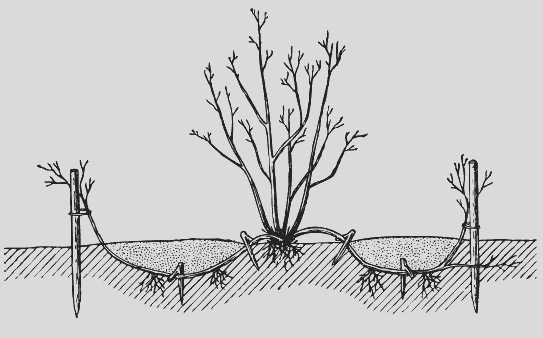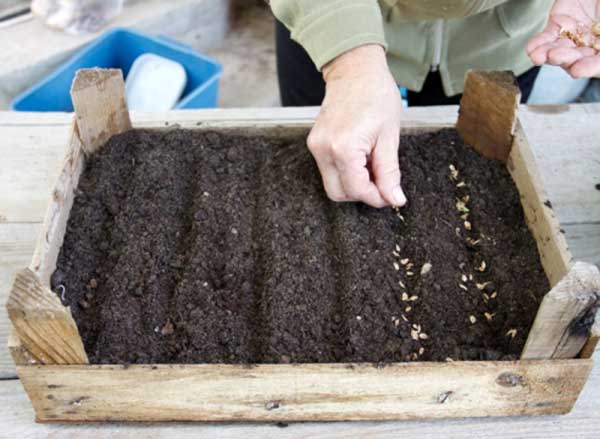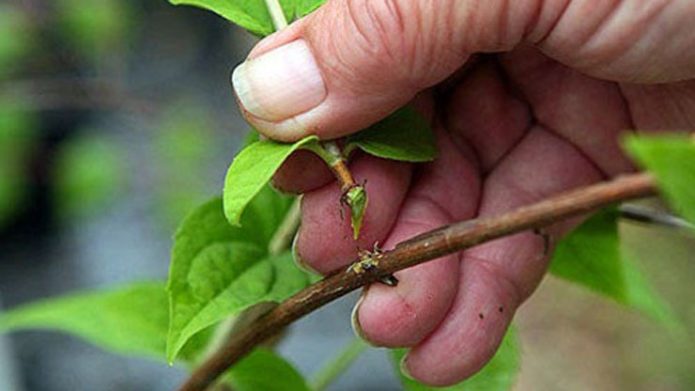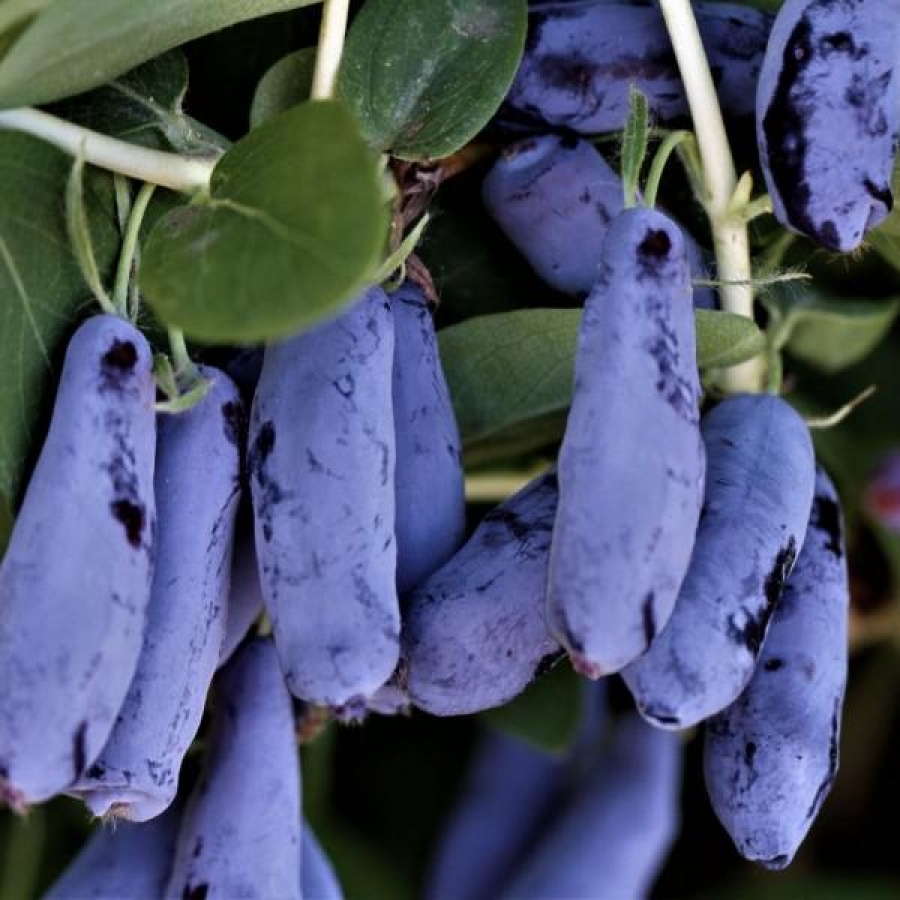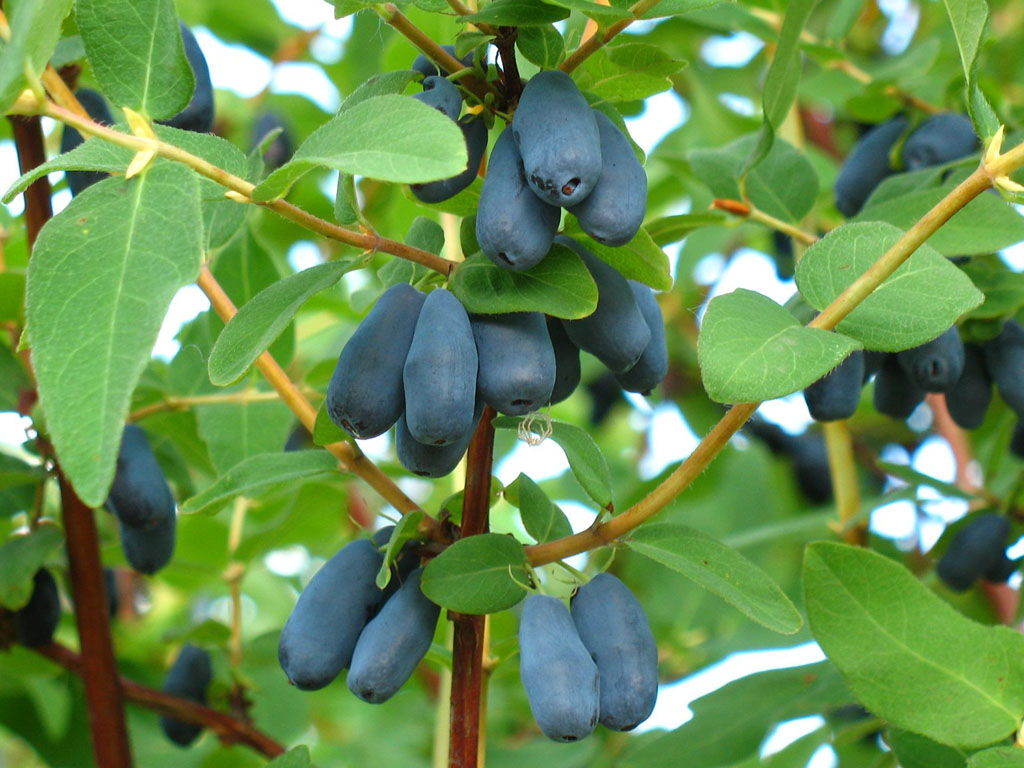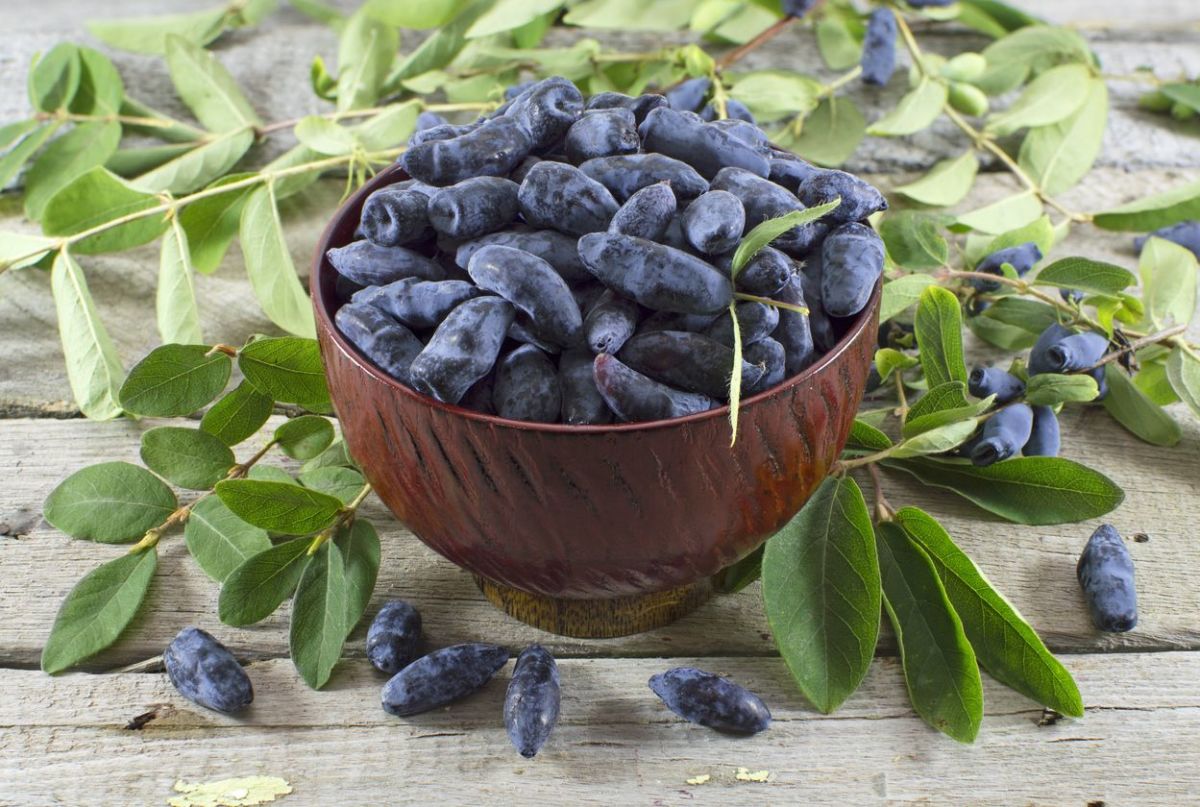Honeysuckle is an infrequent guest on our garden plots: many summer residents do not even know what kind of berry it is. Nevertheless, the berry is quite worthy: it ripens one of the very first, when you still really want vitamins. It is not difficult to plant honeysuckle bushes, and it reproduces in the same way as most berry bushes.
Content
How to propagate honeysuckle
Most summer residents know that it is not at all difficult to propagate, for example, currants, and they do it with success. What about honeysuckle? Almost everything is done in the same way: it reproduces by dividing the bush, horizontal layers, green or lignified cuttings, and even seeds. Not all methods are equally used in the country garden, but it is worth having a brief idea about them.
Reproduction by layering
Let's start with the simplest. For the propagation of honeysuckle by layering, the gardener generally needs to do almost nothing.
We are waiting for the middle of June, when the new shoots are already growing very well, and we are looking closely at the bush. It is necessary to choose the most powerful shoots from those that grow closer to the edge and can be easily bent to the ground. How many shoots do you need? Yes, one is enough, but just in case a couple.
We take a hoe and in the place where the selected shoot will lie, we thoroughly loosen the soil. If it does not give in, we dig shallowly with a shovel or a hand cultivator. We find a thick wire and make several brackets of 8 centimeters in length from it. No wire at all? Also not scary. Cooking several pieces of bricks or stones.
We lay the shoot on the ground, trying not to break it, and in 2-3 places we pin it down with wire or press it with stones. You can even dig a shallow groove first, 3-4 centimeters, it will be even more convenient to lay. We fall asleep with soil a few centimeters high. The top of the shoot has the right to stick out: it must see the sun and know where to strive! We water our workpiece well. If the soil is heavy and often cracks from watering, mulch with a thin layer of dry soil or compost.
During the summer, we systematically water the cuttings. You don't need to be wet, you need to be wet. Is always. If this is the case, almost every buried bud can make a small bush. At least in a month it will be clear whether it will work.
We leave the entire structure as it is for the winter. Next spring, cut off the pinned shoot with a pruner, carefully dig it up and cut it into ready-made seedlings with roots. We throw out the bad ones, and put the good ones in a permanent place. In a couple of years they will bloom.
Seed propagation
Seed propagation is a hassle for "hot lovers". And, most importantly, it is not clear in advance what will happen: it is not at all guaranteed that it will be a seedling of the variety from which you took the seeds. For most berry growers, seed propagation is the prerogative of breeders, it is mainly used to develop new varieties. But if you want to experiment, let's try.
So, it's the same June, the end of the month. Or early July.The honeysuckle bush is ripe with dark blue berries. In most varieties, ripe berries do not stick to the branches, they easily crumble. We take 10-15 pieces of ripe soft berries and extract seeds from them using any available method. For example, rubbing the pulp through a fine strainer. The seeds are also small, but not very: 2 millimeters maximum. We rinse thoroughly with water and decide: to plant immediately or in autumn? If not immediately, dry well and store in a paper bag (no more than 2 years). But you don't have to wait.
Sowing seeds in summer
Any light soil is suitable for germinating seeds, it is important that it does not dry out quickly. It is best to take equal parts of humus, earth and sand, adding a little ash. We pour the soil into any box, moisten it and sow the seeds very shallowly: to a depth of about 1 mm, for example, like snapdragons or annual phlox. We cover with glass and make sure that it is constantly humid in such a "greenhouse". In order not to engage in unnecessary thinning, you should try to sow the seeds about 1 cm apart. If it is difficult, it doesn’t matter, just in 20–25 days, when the seedlings hatch, you will have to arm yourself with small tweezers, and someone with a magnifying glass, and start pulling out the extra ones. The seedlings will live in the box for a long time. Not even until autumn, but until next year. It is necessary to take care of them as for seedlings of vegetable crops: water, loosen, maybe even feed them a couple of times with complex fertilizer. But in late autumn, right in a box, they will have to be taken out into the street, where they, covered with snow, will winter. What if there will be no snow? Well, yes, for the first time it is necessary to cover the box with burlap or spunbond.
In winter, the seedlings will continue to grow in the open air. And as soon as it becomes clear that they can be transplanted (although they will still be only a few centimeters high), carefully take out one from the box and dive into the garden at a distance of 5-7 cm from each other. In the garden we take care of them again like small children until they grow up. And they will grow up in another year, and then, most likely, they can be planted in a permanent place. And after another three years, try the first berries.
Is it possible to do without boxes and sow directly into the garden in the country? Of course, it is possible, but it will be much more difficult to care for: to monitor the constant soil moisture in the garden and the slow growth of miniature seedlings, not every summer resident can do it, especially those who come to the site only on weekends.
Sowing seeds in autumn
If you do not want to bother with the boxes in the apartment, you can wait for autumn by removing the dried seeds in a bag in the nightstand. And already in November we take the same box with soil and sow seeds into it in the same shallow way. We immediately take the box out into the street, where it will winter. Until spring, the seeds of honeysuckle will naturally undergo stratification, and in the spring sprouts should hatch and begin to grow. Dry seeds, sown without stratification, sprout only after a month, and all this month it would be necessary to monitor soil moisture.
If we want to speed up the process, and there is a greenhouse at the dacha, then in early spring the box can be brought there, the seeds will sprout faster. Further care is the same as for home crops. The question is: why bother with summer sowing at home then? So it's safer at home, under supervision! Growing honeysuckle from seeds requires special attention: careful watering, surface loosening.
Throughout the summer, the main thing is to observe the humidity regime. Regular watering is needed until the beginning of autumn, when 3-4 pairs of leaves are formed on the seedlings. They also need to be protected constantly from the bright sun on hot days.
Even if the seedlings of honeysuckle from seeds appeared on time and amicably, this does not mean that everything will be fine. Their growth can stall for one reason or another, but most often - due to a lack or, conversely, an excess of moisture. Watering should be moderate and gentle so as not to wash out tiny plants from the soil.It has a detrimental effect on young bushes and heat. As for nutrition, there are most likely no problems here: the seedlings still need a little more.
In addition, usually not all seedlings grow equally. There is nothing to do, the weakest will have to sacrifice, and why do we need a lot? But we also remember that seed reproduction does not guarantee the desired variety. And, perhaps, it is the poorly growing specimens that could produce more delicious berries. But what to do, a lottery ...
Video: growing honeysuckle from seeds
Propagation by cuttings
Propagation by cuttings is one of the most popular ways to propagate berry trees. In case of honeysuckle, propagation is possible by green, lignified and combined cuttings. Perhaps the easiest to work with is woody cuttings.
They are harvested and planted in the ground in early spring, while the buds are still sleeping. The thicker the stalk, the better; optimal - 7–8 mm in diameter. Length - 15–20 cm. Planting technique - elementary: in loose soil, right in the garden, you need to stick the cutting about halfway. We leave two buds above the ground: one at the level of the soil, the second - as it turns out. If you put a plastic bag on the handle, the danger of drying out will be minimized, and after a month it should already sprout.
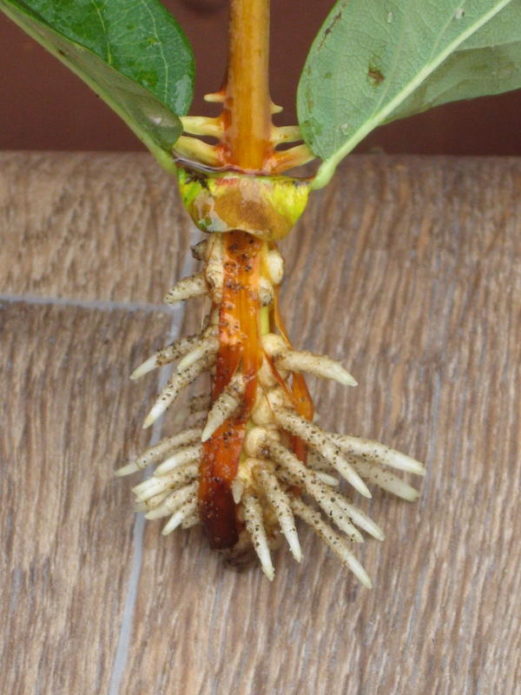
Such roots on the handle indicate that now he can get his own food from the soil and can be planted in a permanent place
Green cuttings are more difficult. They can be cut and planted all summer long, but they should not be completely grassy: they should break when bent. Cuttings up to 15 cm in size are best kept in a solution of a growth stimulant, and of the 3 buds left on the cuttings, the leaves are not cut off from the top, but cut in half; the other two are carefully cut off without damaging the kidneys. They are planted in the same way as lignified ones, but it is imperative to cover it with a film to constantly monitor the humidity under it: both water and air ... You will not leave the site for a long time.
Combined cuttings are prepared from the growth of the current year, but cut so that the heel of last year's shoot remains on them. This is done immediately after the flowering of the bush and be sure to soak the cuttings in a solution of heteroauxin or root. They are planted to a depth of about 5 cm and also covered with a film, keeping an eye on the moisture underneath. The roots should appear in three weeks.
Honeysuckle grafting on honeysuckle
Grafting of honeysuckle, as in the case of other fruit crops, is carried out in order to obtain the desired fruit variety. However, it is clear that since honeysuckle is a shrub, this variety will only be on the shoot on which we will inoculate. As a rootstock, you can take Tatar honeysuckle, which is easily grown in standard form, and then we get a small tree.
Honeysuckle grafting is usually done by budding, that is, with a sleeping eye, while the stock must have a shoot thickness of at least millimeters. Although grafting with a cuttings, copulation is also possible. The time for vaccinations is early in the spring, while the snow is still lying, or in the fall, after leaf fall.
Obviously, different varieties of honeysuckle can be grafted into one bush on different shoots. This is all the more useful, since for normal pollination of honeysuckle in the garden, it is necessary to have several varieties of it.
Video: honeysuckle grafting
Breeding honeysuckle is no more complicated than propagating other berry bushes. There is both a field for experiments and a simple, well-trodden path. In the absence of time and skills, seedlings can be obtained quickly and reliably using the layering method, and if you want to work hard, you can try seed propagation or grafting.
